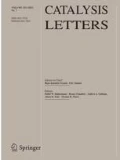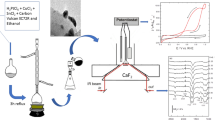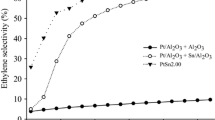Abstract
The decomposition of ethanol has been investigated on Pt metals supported by carbon Norit of high surface area. The reaction starts above 450 K and approaches total conversion at 673–723 K. The major products are H2, CO and CH4. The selectivity of hydrogen formation on all metals supported by carbon Norit scattered around 30%, and almost ~40% of the hydrogen content of ethanol has been converted to gaseous hydrogen at the total conversion. The order of the efficiency of the metals based on the turnover frequencies is Ru > Pt > Ir > Rh > Pd. An advantageous feature of the Norit-supported Pt metals is that no deactivation occurred at 723 K in 10 h, which is in contrast to the behaviour of Pt/Al2O3. The high stability of the catalysts is attributed to the lack of reactive OH groups required for the formation of acetate poisoning the metals. Adding water to ethanol only slightly improved the production of hydrogen.
Similar content being viewed by others
1 Introduction
It has been known for long time that the oxidic supports can not be considered as a completely neutral material, but depending on its nature it can dramatically influence the catalytic performance of the deposited metals. One of the best examples for this phenomenon is the occurrence of an electronic interaction between the metal and the support [1]. Following the initial work of Schwab et al. [1], who used isolating alumina support, it was shown that the application of n-type TiO2 and the variation of its electric properties dramatically influences the catalytic performance of supported Ni [2]. This finding was confirmed and followed by the huge amount of works using Titania as a support [3–6]. There are some cases, however, when a side reaction occurs on the support and the surface compounds formed influences the performance of the catalysts. This phenomenon was first discovered by Tsu and Boudart [7]. A good example for this feature is reforming of ethanol on alumina-supported Pt metals, which has been the subject of an extensive research [8–20]. In spite of the high initial activity, the production of hydrogen on Pt/Al2O3 is drastically decreased in time at 723–823 K [18, 19], which was attributed to the poisoning effect of acetate formed on the catalyst [18, 19].
Recently we reported that Mo2C prepared by the reaction of MoO3 with multiwall carbon nanotube and activated carbon Norit is an excellent catalyst for the decomposition of ethanol to H2 [21, 22]. This solid was also effective in the decomposition/reforming of methanol [23] and dimethyl ether [24]. Complete decomposition of the alcohols was achieved at 623–673 K. In optimum case more than 60% of the hydrogen content of ethanol introduced has been converted into gaseous H2. The remarkable feature of the Mo2C/C catalyst both in the decomposition and reforming of ethanol is its high stability, which means that the conversions and the H2 yields decreased only by few percents even after 75 h of reaction at 723 K. The primary aim of this work is to examine the catalytic behaviour of Pt metals supported by carbon Norit, when the formation of acetate and the subsequent deactivation can be assumedly avoided.
2 Experimental
2.1 Methods
Catalytic reaction was carried out at 1 atm of pressure in a fixed-bed, continuous flow reactor made of a quartz tube (8 mm id) [21, 22]. The flow rate was in general 40 mL/min. The carrier gas was Ar, which was bubbled through ethanol at room temperature: the ethanol content was ~9.0–10 vol%. Generally 0.3 g of loosely compressed catalyst sample was used. Reaction products were analysed with a gas chromatographs: a HP 5890 equipped with PORAPAQ Q and PORAPAQ S packed columns. In the study of the reaction of alcohol–water mixture of different composition, the reactants were introduced into an evaporator with the help of an infusion pump (MEDICOR ASSISTOR PCI flow rate: 1.0 mL liquid/h): the evaporator was flushed with Ar-flow (36 mL/min). Alcohol or alcohol–water containing Ar-flow entered the reactor through an externally heated tube avoiding condensation. The conversion of alcohol was calculated taking into account their amounts consumed. This value generally showed a good agreement with those determined on the basis of H and C content of the reactants and products. To establish the efficiency of the catalyst as regards the production of hydrogen, the percentage of the H2 related to the hydrogen content of ethanol decomposed was also calculated. This value is termed as “H2 eff”. The DRIFTS analyses were performed in a diffuse reflectance infrared cell (Spectra Tech) with a CaF2 windows, adapted to a BioRad FTS-155 type FTIR spectrometer with a wavenumber accuracy of ±4 cm−1.
2.2 Materials
Carbon Norit support was purchased from ALFA AESAR. It has been purified before by treatment with HCL (~10%) for 15 h at room temperature. After this cleaning procedure, the metal impurities were less than 0.02% as determined by the ICP-AES method. The surface area of the purified carbon Norit is 859 m2/g. The supported catalysts were prepared by impregnating the carbon support with solutions of metal compounds to yield a nominal 2 wt% metal. The following salts of Pt metals were used: H2PtCl5·6H2O, PdCl2, RhCl3·3H2O, H2IrCl6 and RuCl3·3H2O. The impregnated powders were dried at 383 K. The fragments of catalyst pellets were oxidised at 673 K for 30 min and reduced at 673 K in the catalytic reactor for 60 min. XPS measurements revealed the complete reduction to metals.
3 Results and Discussion
Figure 1a shows the conversion of ethanol on various Pt metals supported by carbon Norit. The decomposition begins already above 450 K and it is complete at 673–723 K. On the basis of the conversion measured at 573 K, the efficiency of the catalysts is decreasing in the order: Ir > Pt ~ Rh > Ru > Pd. The product distribution measured on three catalysts, Pt/Norit, Rh/Norit and Ir/Norit as a function of temperature is plotted in Fig. 2. On Pt/Norit the major products are H2, CO and CH4, which are formed practically in the same amount, 28–32%. Much less quantity (~5%) of ethane was also measured. Minor products are acetaldehyde, ethene, propene, diethyl ether and propane. Very similar product distribution with deviant temperature dependence was obtained on the other Pt metals. Ir/Norit is a noteworthy difference, where acetaldehyde was a major product at 473–573 K, which disappeared completely only at 673–723 K. Following the reaction in time on stream on Pt/Norit at 723 K, when we measured complete decomposition, we experienced no or only very little deactivation of the catalyst for several hours (Fig. 1b). No deterioration was measured for other Norit-supported metals, and only a slight one for Pd/Norit. Although the Norit-containing samples are not the best samples for DRIFTS studies, we were able to detect the absorption band of adsorbed CO in the range of 1,960–2,030 cm−1 depending on the metals, but no other surface species, formate or acetate, were identified.
When the rate of decomposition of ethanol are related to the number of surface metal atoms, taking into account the dispersion of the supported metals, we obtained the following order for the formation of hydrogen: Ru, Pt, Ir, Rh and Pd. Same order was calculated for the production of CO. Data are shown in Table 1.
On 2% Ir/Norit catalyst we performed kinetic measurements. Experiments were executed in temperature range of 453–533 K. The partial pressure of ethanol was varied keeping the total flow rate at 40 mL min−1 by adding argon ballast to the system. The conversion level of ethanol was between 0.9 and 15%. The reaction of alcohol under these conditions followed first order kinetics. From the Arrhenius plots we obtained 73.9 kJ/mol for the activation energy of the decomposition of ethanol and 71.8 kJ/mol for the formation of hydrogen.
Experiments have been also performed as regards the steam reforming of ethanol. Using ethanol/water (1/3) reacting mixture the conversion of ethanol somewhat lowered for all catalysts, and the total conversion was attained at higher temperatures. There was, however, very little alteration in the product distribution, e.g. in the formation of the hydrogen, which means that water did not enter reaction either with ethanol or its decomposition products. The possible reason is the lack of reactive OH groups on the carbon Norit support.
As shown in Table 1 the selectivity of hydrogen formation on all metals supported by carbon Norit scattered around 30% at the total conversion of ethanol. In the appreciation of this value we note that the selectivity of H2 formation in the decomposition of ethanol on 1% Pt/Al2O3 at 723 K was only 1.51%, which increased only to 5.71% (ethanol/water 1/3) and 25.2% (ethanol/water 1/9) in the reforming of ethanol at the steady state [20]. One of the reasons of these low values is that the alumina support (Degussa P 110 C 1,100 m2/g) used mainly catalyses the dehydration of ethanol [19]. In contrast, the product distribution determined on Norit-supported metals suggests the occurrence of the dehydrogenation reaction, which consists of two primary steps
Acetaldehyde, however, decomposes rapidly to methane and CO
and completely disappeared from the products at 673–723 K. The formation of a small amount of ethane indicates that we can also count with the rupture of O–H bond in the adsorbed ethanol
to yield ethyl species, which will be hydrogenated to ethane
The study of chemistry of C2H5 species on Rh(111) [25] and Mo2C/Mo(111) [26] by various spectroscopic methods revealed that its hydrogenation and dehydrogenation occur parallel. The formation of the little amount of ethene could be the result of the latter process, or that of the dehydration of ethanol
Another important feature of Norit-supported metals is the high stability: neither the total conversion nor the data for hydrogen production underwent any decay in 10 h. This is in contrast to the Pt/Al2O3 catalyst, where a dramatic reduction in the selectivity of hydrogen was observed at 723 K, which was attributed to the formation of acetate in the oxidation of adsorbed acetaldehyde by the reactive OH groups on the alumina [19, 20]. This acetate detected by FTIR spectroscopy is assumedly migrated from the alumina to the metals or to the metal/support interface. FTIR measurements executed during the catalytic decomposition and reforming of ethanol on Pt/Norit, however, did not indicate the formation of acetate groups. This is very likely due to the lack of OH groups on Norit, which prevented the formation of acetate, and thereby the deactivation of Pt catalysts. Nevertheless the disadvantage of metals/Norit catalysts is that they do not catalyse the water gas shift reaction: accordingly its combination with other catalyst is needed for the elimination of CO.
Finally we may compare the catalytic behaviour of Norit-supported metals, with that of Mo2C/Norit. This latter solid exhibited a similar high activity in the decomposition of ethanol [21, 22], as measured on Pt metals/Norit. It mainly catalysed the dehydrogenation of ethanol (Eq. 1, 2) yielding hydrogen and acetaldehyde. The selectivity of hydrogen at 723 K was 28–38%. Mo2C/Norit, however, was not active for the decomposition of acetaldehyde, which was a fast process on the samples used in the present work.
4 Conclusions
-
(1)
Pt metals deposited on carbon Norit support effectively catalyse the decomposition of ethanol to yield mainly H2, CO and CH4.
-
(2)
On the basis of specific activity Ru/Norit is the most active catalyst.
-
(3)
The advantageous property of carbon-supported Pt metal catalysts compared to the Pt metals/Al2O3 is the high stability. This is very likely due to the absence of OH groups on carbon responsible for the acetate formation in the case of Pt/Al2O3.
References
Schwab GM, Block J, Müller W, Schultze D (1957) Naturwissenschaften 44:582
Szabó ZG, Solymosi F, Batta I (1958) Z Phys Chem N F 17:125
Szabó ZG, Solymosi F (1961) In: Proceedings, 2nd International Congress on Catalysis. Technip, Paris, p 1627
Solymosi F (1967) Catal Rev 1:233
Schwab GM (1978) Advances in catalysis, vol 27. Academic Press, New York, p 1
Solymosi F (1985) J Catal 94:581
Haller GL, Resasco DE (1989) Advances in Catalysis, vol 36. Academic Press, New York, p 173
Tsu K, Boudart M (1961) In: Proceedings, 2nd International Congress on Catalysis. Technip, Paris, p 593
Díagne C, Idriss H, Kiennemann A (2002) Catal Commun 3:565
Breen JP, Burch R, Coleman HM (2002) Appl Catal B: Environ 39:65
Liguras DK, Kondarides DI, Verykios XE (2003) Appl Catal B Environ 43:345
Fierro V, Klouz V, Akdim O, Mirodatos C (2002) Catal Today 75:141
Klouz V, Fierro V, Denton P, Katz H, Lisse JP, Bouvot-Mauduit S, Mirodatos C (2002) J Power Sources 105:26
Aupretre F, Descorme C, Duprez D (2002) Catal Commun 3:263
Marino F, Baronetti G, Jobbagy M, Laborde M (2002) Appl Catal A Gen 238:41
Llorca J, Homs N, Sales J, de la Piscina PR (2002) J Catal 209:306
Sheng P-Y, Yee A, Bowmaker GA, Idriss H (2002) J Catal 208:393
Erdőhelyi A, Raskó J, Kecskés T, Tóth M, Dömök M, Baán K (2006) Catal Today 116:367
Dömök M, Tóth M, Raskó J, Erdőhelyi A (2007) Appl Catal B 69:262
Basagiannis AC, Panagiotopoulou P, Verykos XE (2008) Top Catal 51:2
Barthos R, Széchenyi A, Solymosi F (2008) Catal Lett 120:161
Barthos R, Széchenyi A, Koós Á, Solymosi F (2007) Appl Catal A Gen 327:95
Barthos R, Solymosi F (2007) J Catal 249:289
Solymosi F, Barthos R, Kecskeméti A (2008) Appl Catal A Gen 350:30
Bugyi L, Oszkó A, Solymosi F (1996) J Catal 159:305
Solymosi F, Bugyi L, Oszkó A, Horváth J (1999) J Catal 185:160
Acknowledgments
This work was supported by the OTKA under contract number NI 69327. A loan of rhodium chloride from Johnson-Matthey PLC is gratefully acknowledged.
Author information
Authors and Affiliations
Corresponding author
Rights and permissions
About this article
Cite this article
Gazsi, A., Tolmacsov, P. & Solymosi, F. A Comparative Study of the Decomposition of Ethanol on Pt Metals Supported by Carbon. Catal Lett 130, 386–390 (2009). https://doi.org/10.1007/s10562-009-9984-0
Received:
Revised:
Accepted:
Published:
Issue Date:
DOI: https://doi.org/10.1007/s10562-009-9984-0






